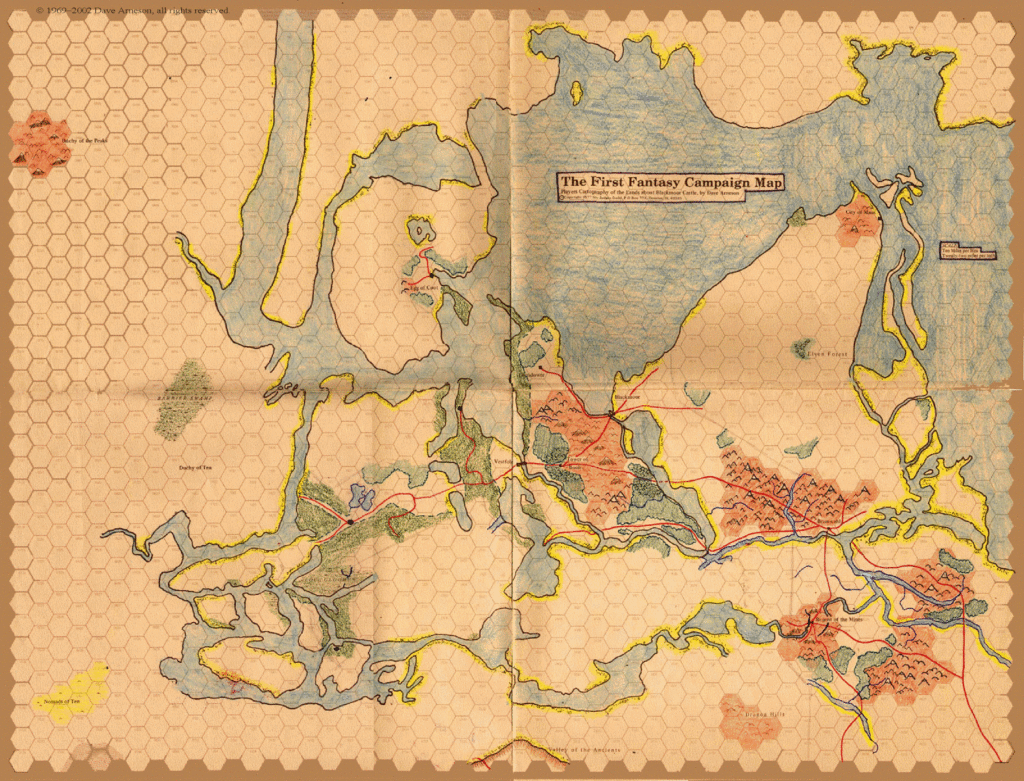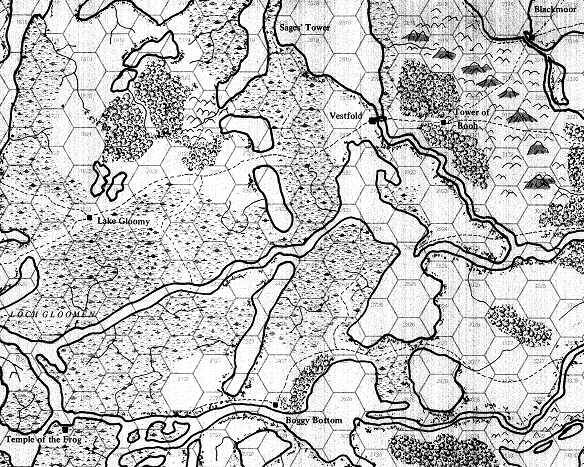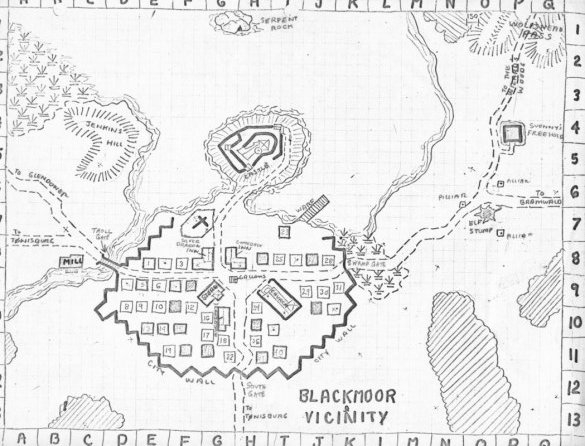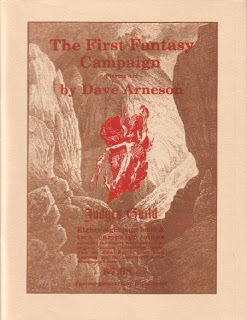Most of you have read some version of the creation of Dungeons and Dragons. The early versions of the game were more or less the work of two men: Gary Gygax and Dave Arneson. Arneson, it is said, took the rules of Chain Mail that were created by Gary Gygax and Jeff Peren used them in an unintended (and unexpected) way. He took a group of people through a dungeon adventure using these rules for fantasy combat and a new game was born. That is the legend anyway. But few seem to dispute that Dave Arneson was the first to make an official campaign for the game. This product is the notes from that original campaign from Dave Arneson himself. He published this work with the help of Judges Guild in 1977.
This is not a module. Be clear on that point. You are not going to buy the First Fantasy Campaign and then run the Blackmoor campaign from it. This work is 67 pages long and contains most of the maps used in that campaign. It does not, however, offer detailed versions of each of the dungeons and castles from that campaign. This is more like a compilation of notes from that campaign.
What this product is, however, is a window into the creation of the game itself. And it is a view of the creation of the early ideas in fantasy gaming. It is an interesting read. And for that it is worth reading if you can get a copy.

What I like about the First Fantasy Campaign
It is always interesting to find and read stuff from these early campaigns. I can remember reading about Greyhawk from the original D&D booklets and then wondering what such a campaign would look like. Back in those days (early 80s) none of the Greyhawk material had yet been published. A ton of it is available now. But back then it was a name. And there were all these spells in the PHB (1st Edition) named after characters in that campaign. And then there was the Rogues Gallery that came out in that time frame. It also listed personalities from that campaign. You can imagine how much I was looking forward to it when the Greyhawk Folio came out. I waited in anticipation for it to come in the mail. And then….it turned out to be just some maps and a booklet with short descriptions on some of the kingdoms and empires in the world. There was no real discussion about the world or the characters in it. There was little real discussion of the politics or the personalities or the villains and heroes. But it was Greyhawk! So it was gold.
So naturally I read this Judges Guild product with anticipation. It does give some flavor for what the campaign was about. Clearly from reading this text it began with a single dungeon. Actually it was more of a castle with many levels. Six to be exact. And apparently Dave Arneson felt that six levels was far too few. So he made other dungeons. And made them much deeper. And from that framework he built towns and cities and a game universe around it.
This product is more of a pile of lists. Lists of castles. Lists of towns. Lists of important characters. There are also many maps. Maps of the world. Maps of specific and important areas within that world. Maps of the town of Blackmoor. Maps of the castle and dungeons beneath it. Some of this even appears to be hand drawn by the author.
One aspect of reading this product is that you can quickly begin to realize that the author was still thinking in terms of wargaming rather than role playing when he made these notes. There are lots of entries involving armies and generals and their makeup. At the beginning Dungeons and Dragons was a derivative of Chainmail. And Chainmail was essentially a list of rules for use with fantasy armies. At the earliest stages of the Blackmoor campaign that transition to a role playing game was still being made.
What I do not like about the First Fantasy Campaign
It is incomplete. It is not a module per se. You cannot really run this campaign or an adventure within it from the First Fantasy Campaign. These are notes on that campaign. They are not anything like the professional modules that came much later. In fact there is really only one dungeon within this product. And even it is incomplete. There are lots of rooms listed. Some have notes regarding monsters or treasures. Others have no details at all. This could signify that those rooms are empty….I suppose. But I would expect some kind of indication that this is the case. Even the early Judges Guild adventures, as brief as their descriptions often were, stated that a room was empty if it was. My conclusion would be that the notes listed in this product were an early version of that dungeon but not the final one.
It is far too short. There were six or seven dungeons (or castles) according the the author. Yet only one was shown in any form in this product. I would like to see the others too. And the descriptions of the important entities and characters is far too short. They do not really give the full flavor of the campaign world.

Would I recommend this product to others?
If you are interested in the history of Dungeons and Dragons then absolutely. This is worth reading. If you want to run this campaign with your players then probably not. I do not think one can read this product and learn enough from it to make it work well.
Would I run the First Fantasy Campaign with my own players?
For the reasons I stated earlier…..No. Because this is not a complete module. Nor would I try to reconstruct the campaign from these notes. The notes in the First Fantasy Campagin are scattered. While the author surely understood them and how they fit….I do not. They are confusing. There are lots of non player characters and places and names and maps. How, exactly, they all fit together is really unclear even after reading this product from cover to cover.
If you enjoyed this article then perhaps you will enjoy these as well:
- Caverns of Thracia Review
- The Maltese Clue Review
- Verbosh Review
- Lara’s Tower Review
- Restormel Review
- The Dragon Crown Review
- Escape From Astigar’s Lair Review
- Hall of the Fire Giant King Review
- Glacial Rift of the Frost Giant Jarl Review
- Steading of the Hill Giant Chief Review
- Tegel Manor Review
- F’Deck Fo’s Tomb Review
- Operation Ogre Review
- Inferno Review




The worst thing is that even as a book about the history of D&D and roleplaying it is unfinished. It certainly is a fascinating read, and one can pick out lots of interesting tidbits, but putting all of it together is a frustrating experience. Dave didn’t seem to be quite sure what people even wanted in this book. He tries to show off that awesome thing he created, but it neither explains the setting properly, nor does it go into the detail of the campaign itself too much.
I enjoyed reading through it but found the lack of description of any of the dungeon levels to be disappointing. I kind of got the idea that perhaps he ran a more ad lib kind of game than I do. But I discovered that someone else apparently released a “Dungeons of Blackmoor” which has more detail about the levels of the dungeon than this Judges Guild product had.
This matches very much with Tim Kask’s description of all the content received from Arneson. It’s quite clear that he only documented outlines of things as needed and improved his way through the rest. I expect it was a fascinating thing to play in his world but it waa never meant to be anything that someone else could pick up on a recreate as Arneson played it. It took someone like Gygax to turn it into something for the rest of us and create the whole genre that we know as Dungeons and Dragons. Note that this does not detract from anyone’s value or influence on the creation of RPGs. It just shows that everyone had a part to play and without those particular people at that particular time we’d have something very different today.
Honestly it is a shame that it was not a more complete adventure. I would have loved to have played through it.